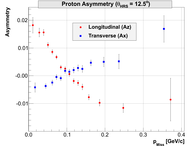E05-102 Analysis
Elastic Proton Asymmetries:
I have returned to the analysis of data at pmiss = 0, which should
approx. correspond to the elastic scattering of electrons on the polarized
proton target. The idea is to extract proton polarization inside 3He Nucleus.
Here are my data:
1.)  2.)
2.) 
Test with the MIT-Bates Data:
To double check that my code for the elastic-proton asymmetry calculation works
properly, we compared the calculated values with the measurements from MIT-Bates.
Here is the comparison. It seems that measured values (Crawford et al, PRL98) agree
well with my calculations.
3.) 
Analysis Results:
I have modified my fitting technique. Earlier I was using central parameter values for both
kinematics settings. That enabled me to fit both fitting points (longitudinal and transverse point)
for each setting directly to a fitting curve. See the following link.
MeetingNo70.html
For the latest analysis I considered different approach. For longitudinal points, \phi* angle is a priori 0.
However, for transverse points phi* is equally distributed over wide range of angles +/-40deg. I have
decided to consider this in my analysis, by integrating the elastic-asymmetry formula over the whole range
of angles. This has introduced a following change in the elastic-scattering formula:
cos(phi*==0) --> 0.25*(2sigma + sin(2*sigma))/(sin(sigma))
where sigma corresponds to the width of the phi* distribution. When applied to my data this
modification brings 8% correction to one of the terms in the asymmetry formula (1--> 0.926).
Because of this modification in the analysis, I was not able to fit my data points directly to the curve, but
had to used point to point comparison. I also decided to analyze all 4 points (2x2) together and
find a common polarization parameter. Here are my results:
4.) 
Error-bars shown correspond to the statistical errors of each measured points. The 2nd and 4th point (transverse
points) have larger error-bars due to smaller absolute value of the asymmetry.
My analysis was primarily done in root. However to double check, I also did it in Mathematica:
ProtonElasticAsymmetryDecember.pdf
As before we got a fitting parameter approx. 0.2, which means, that in the given conditions means 20% proton
polarization in the 3He. Now we are in a search of a toy model, that would explain this kind of behavior.
NIKHEF Comparison:
As additional test I used my approach on NIKHEF Deuterium data. Here the same approach applies. In the
low missing-momentum region this asymmetry should directly correspond to the elastic proton asymmetry
(100% polarization).
6.) 
Measured values are: Q**2 = -0.21(GeV/c)**2, thetaBB=40deg, theta* = 90deg. phi* = 0, Asymmetry ~ -0.27.
Calculated asymmetry = -0.32, which deviates approx. 14% from the measured value.
Last modified: 12/07/11
 2.)
2.) 


